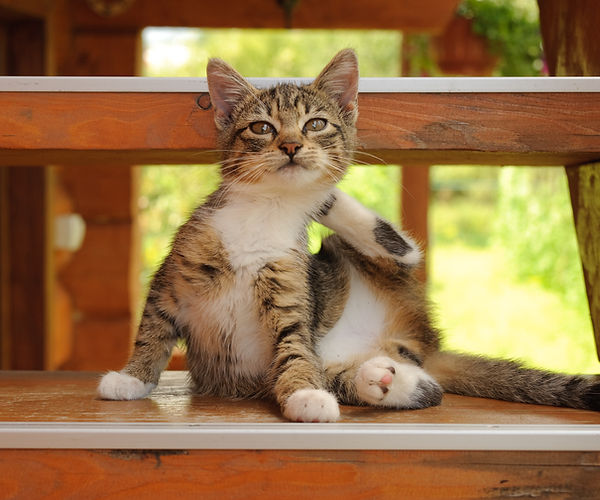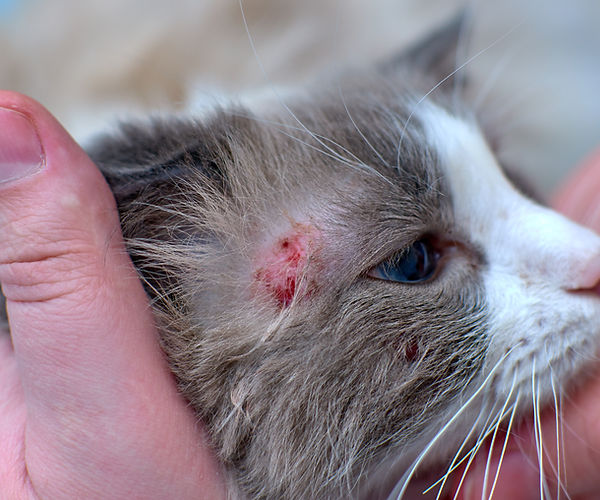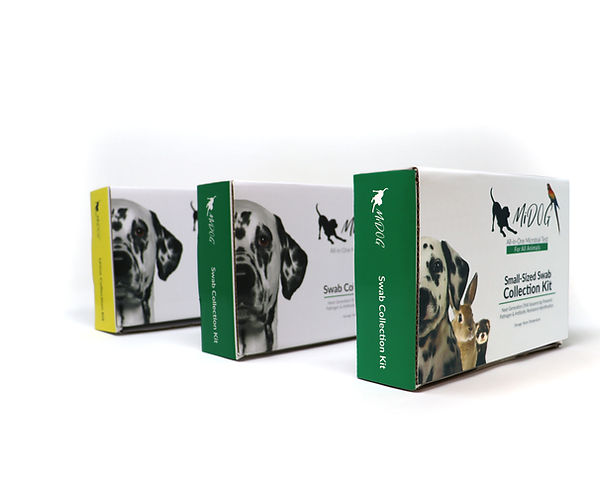
The feline microbiome may be more linked to the development of atopic dermatitis than previously thought.
Has your cat been itching and scratching their skin more often than normal? If so, your furry friend may be suffering from feline dermatitis! Feline dermatitis is a general term that describes inflammation or irritation of the skin [1]. This condition can manifest in several ways, and has long been associated with allergies and environmental factors [2]. However, Next-Gen Sequencing (NGS) technology has allowed veterinarians and researchers to understand the more complex, multifactorial etiology of feline dermatitis that can be further complicated by the cat’s skin microbiome and secondary bacterial infections caused by excessive itching and inflammation.
Treatment for chronic itching can be frustrating, and while it may be tempting to find an at-home remedy for your cat, it is particularly important to visit a veterinarian in order to understand the underlying cause of your cat’s itching. While some studies have explored the efficacy of natural remedies for feline dermatitis, research is overwhelmingly scarce [3]. Moreover, without the guidance of a veterinarian, you may inadvertently expose your pet to natural treatments that do more harm than good!
What Causes Dermatitis in Cats?
The most common cause of feline dermatitis is fleas, while the second most common cause is environmental allergens [4]. Approximately 12.5% of cats suffer from allergen-induced dermatitis, with the most notable allergens being pollen, grass, fungi, mold, dust, and even household products (like perfume, cleaning products, and cigarette smoke) [4].
Up until the last decade, the relationship between skin dysbiosis and allergen sensitivity has not been studied much; however, the increasing integration of NGS in veterinary medicine has helped illuminate this complex relationship! Most notably, there are more bacterial species inhabiting the skin of cats than previously thought, and there is evidence of an association between dysbiosis and skin diseases like allergies and dermatitis [5]. Healthy cats had more Oxalobacteraceae and Porphyromondaceae, while allergic cats had more Staphylococcus [5]. In fact, a separate study found that antimicrobials from the healthy feline microbiome are able to inhibit skin infections by drug-resistant Staphylococcus pseudintermedius [6]!
For any cat parent, identifying symptoms of pruritus is useful and can help your veterinarian identify the cause of your cat’s itching. Symptoms include:
- Severe itching
- Excessive scratching
- Hair pulling
- Skin redness
- Skin swelling
- Hair loss
- Lesions
- Small bumps on skin
- Raw skin

The image above depicts a cat suffering from allergic dermatitis. Notice the skin lesion and small bumps on the skin.
Harmful Effects of Avoiding Medical Treatment For Your Cat
When considering integrating herbal remedies into your cat’s care, it is important to note that both herbalists and scientists understand the scarcity in research regarding treatment efficacy. In fact, certain herbs actually induce adverse effects that may harm your cat and/or cause a possible infection to proliferate. Essential oils like cinnamon, citrus, clove, eucalyptus, peppermint, pine tea tree, and several more are all poisonous to cats!
Beyond accidentally giving your cat a natural remedy they may be allergic to, reluctance to simply visit a veterinarian causes a delay in care and may exacerbate your cat’s condition. For example, failure to treat the root cause of your cat’s dermatitis may result in secondary bacterial infections, which often occur in the upper layers of the skin and hair follicles. These infections are frequently triggered by an overgrowth of normal dermal flora including most commonly by Staphylococcus pseudintermedius, along with Micrococcus sp., Bacillus sp., Corynebacterium sp., Escherichia coli, Proteus mirabilis, and Pseudomonas sp [7]. Infection severity ranges widely, from simple infections to complex infections, and from surface to superficial or deep infections [7].
It is worth noting that visiting a veterinarian before your cat’s condition progresses to a condition a secondary bacterial infection may end up being more cost-effective. Progression of a dermatitis skin condition to severe bacterial infection is also painful for your cat, and so consultation with a veterinarian is recommended.
Should I Go To The Veterinarian For My Cat’s Itching?
Yes. If you think your cat is suffering from itchy skin, please consult with a veterinarian as soon as possible. As has been previously mentioned, the potentially multifaceted nature of your cat’s itchy skin results in a complex diagnostics/treatment process that is only further complicated by delaying care. Consequently, having a solid understanding of the potential bacterial presentations in your cat is crucial.
Increasing contemporary evidence has begun to acknowledge the shortcomings of culture-based diagnostic testing, as the “microbiome is much more complex than has been identified with previous culture-based studies” [8]. Several studies have revealed unculturable bacteria have been underestimated, while bacteria with high proliferation rates are possibly overestimated [9]. Recent advances in next-generation sequencing (NGS) technologies allow metagenomics analysis and have provided exciting and practical opportunities for dysbiotic skin interventions.
The MiDOG All-in-One Microbial Test utilizes the NGS technology to detect and quantify all microbial DNA through untargeted and comprehensive sequencing and quantitative comparisons to reference databases. Considering shortcomings in culture-based diagnostics, the MiDOG NGS technology provides a useful opportunity to shed light on the microbial makeup of your cat’s skin microbiome for clinical application. The MiDOG microbiome test is a microbial identification test grounded on scientific research that provides veterinarians DNA evidence for the guided treatment of feline skin infections.

Find out if your vet uses MiDOG before you book your next appointment!
References
[1] Moriello, K. (2018). Dermatitis and Dermatologic Problems in Cats – Cat Owners – MSD Veterinary Manual. Retrieved 26 May 2022, from https://www.merckvetmanual.com/cat-owners/skin-disorders-of-cats/dermatitis-and-dermatologic-problems-in-cats
[2] Gedon, N., & Mueller, R. (2018). Atopic dermatitis in cats and dogs: a difficult disease for animals and owners. Clinical And Translational Allergy, 8(1). doi: 10.1186/s13601-018-0228-5
[3] Mueller, R., Nuttall, T., Prost, C., Schulz, B., & Bizikova, P. (2021). Treatment of the feline atopic syndrome – a systematic review. Veterinary Dermatology, 32(1), 43. doi: 10.1111/vde.12933
[4] Bajwa J. (2018). Atopic dermatitis in cats. The Canadian veterinary journal = La revue veterinaire canadienne, 59(3), 311–313.
[5] Older, C., Diesel, A., Patterson, A., Meason-Smith, C., Johnson, T., & Mansell, J. et al. (2017). The feline skin microbiota: The bacteria inhabiting the skin of healthy and allergic cats. PLOS ONE, 12(6), e0178555. doi: 10.1371/journal.pone.0178555
[6] O’Neill, A., Worthing, K., Kulkarni, N., Li, F., Nakatsuji, T., & McGrosso, D. et al. (2021). Antimicrobials from a feline commensal bacterium inhibit skin infection by drug-resistant S. pseudintermedius. Elife, 10. doi: 10.7554/elife.66793
[7] Titeux, E., Gilbert, C., Briand, A., & Cochet-Faivre, N. (2018). From Feline Idiopathic Ulcerative Dermatitis to Feline Behavioral Ulcerative Dermatitis: Grooming Repetitive Behaviors Indicators of Poor Welfare in Cats. Frontiers In Veterinary Science, 5. doi: 10.3389/fvets.2018.00081
[8] Korbelik, J., Singh, A., Rousseau, J., & Weese, J. S. (2019). Characterization of the otic bacterial microbiota in dogs with otitis externa compared to healthy individuals. Veterinary Dermatology, 30(3), 228-e70. https://doi.org/10.1111/vde.12734
[9] Tang, S., Prem, A., Tjokrosurjo, J., Sary, M., Van Bel, M., & Rodrigues-Hoffmann, A. et al. (2020). The canine skin and ear microbiome: A comprehensive survey of pathogens implicated in canine skin and ear infections using a novel next-generation-sequencing-based assay. Veterinary Microbiology, 247, 108764. doi: 10.1016/j.vetmic.2020.108764
